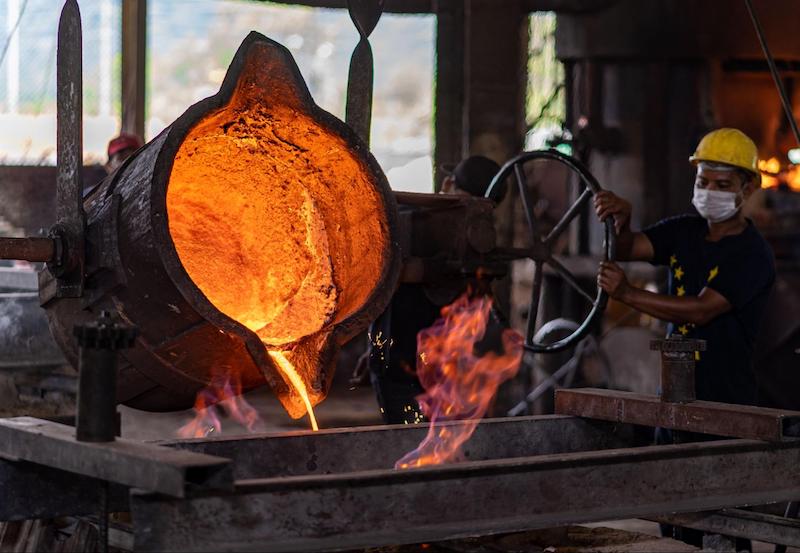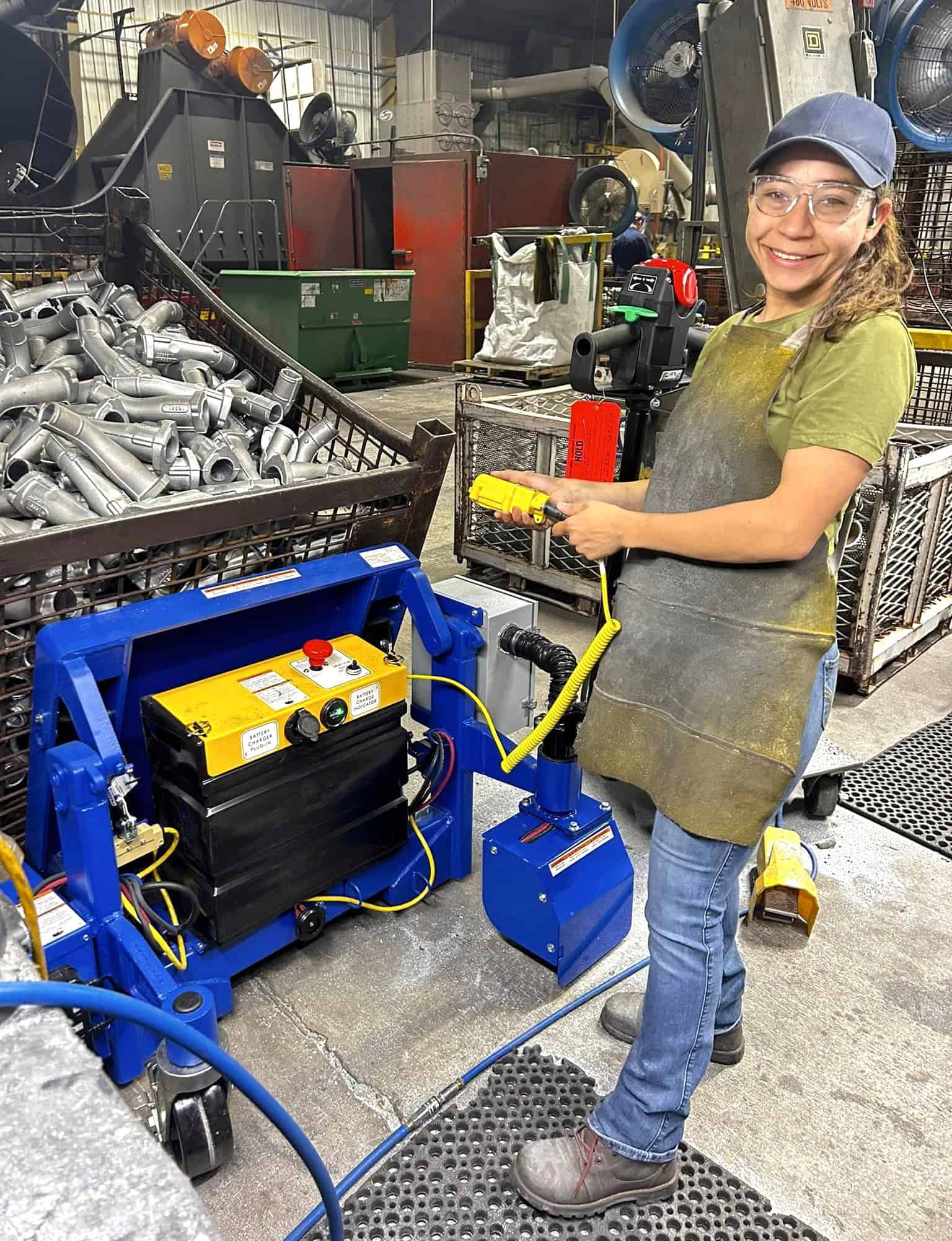The Future of Aluminum Castings and Sustainable Manufacturing
Wiki Article
Discovering the Cutting-edge Methods Utilized in Modern Aluminum Foundries
Modern aluminum foundries are undertaking a considerable change through the adoption of ingenious strategies. Advanced casting approaches, smart automation, and lasting practices are reshaping manufacturing procedures. These advancements not only enhance performance but also address ecological concerns. As the industry develops, the combination of electronic modern technologies plays a necessary duty. Recognizing these changes is important for realizing the future of aluminum manufacturing and its effects for global markets. What lies in advance in this dynamic industry?Advanced Casting Techniques

Furthermore, improvements in thermal control and mold layout have contributed to more consistent casting results. These innovations permit far better control of cooling down rates, reducing issues and enhancing mechanical residential or commercial properties. Consequently, manufacturers can create light-weight yet resilient components, fulfilling the boosting demands of numerous markets, including auto and aerospace, for high-performance aluminum parts.
Smart Automation and Robotics
The integration of clever automation and robotics in aluminum foundries notes a substantial development in making effectiveness. These modern technologies enable accuracy and uniformity in production processes, drastically decreasing human mistake and enhancing security. Automated robot systems handle recurring tasks, such as molding, putting, and cooling, enabling human drivers to concentrate on even more complex obligations that call for essential reasoning and oversight.Additionally, smart sensing units and AI-driven analytics offer real-time information surveillance, assisting in anticipating upkeep and reducing downtime. This causes enhanced source allowance and enhanced energy consumption, adding to overall sustainability in production.
Furthermore, the flexibility of robot systems allows for fast modifications to changing production demands, improving versatility in manufacturing. As foundries significantly take on these innovative modern technologies, they not just enhance operational effectiveness but additionally position themselves as leaders in advancement within the metal casting sector.
Additive Manufacturing in Foundries
Transforming standard manufacturing approaches, additive production is revolutionizing aluminum foundries by enabling the creation of complex geometries that were previously unattainable. This technique allows for the layer-by-layer building of elements, substantially lowering product waste and reducing manufacturing times. Therefore, foundries can produce detailed styles that enhance efficiency and performance, catering to the expanding needs of different industries.Moreover, additive manufacturing promotes quick prototyping, permitting engineers to evaluate and iterate layouts promptly. This dexterity not only increases the advancement cycle yet also assists in recognizing prospective concerns before full-blown manufacturing begins. The assimilation of sophisticated products and processes in additive manufacturing better improves the mechanical buildings of aluminum components, promoting technology in product design. Subsequently, aluminum foundries that embrace these strategies place themselves at the forefront of sector developments, ensuring competition in an ever-evolving market landscape.
Lasting Practices and Recycling
Sustainable techniques in aluminum foundries are progressively concentrated on improving recycling processes and taking on environmentally friendly casting methods. These advancements intend to lower waste and energy usage while maximizing making use of recycled materials. As the market develops, the assimilation of sustainability right into production methods comes to be vital for fulfilling environmental requirements and consumer demands.Recycling Process Improvements
As industries increasingly recognize the environmental influence of waste, aluminum foundries are taking on cutting-edge recycling process improvements to enhance sustainability. These improvements concentrate on reducing energy consumption and maximizing material recovery. For instance, lots of foundries are carrying out closed-loop systems that recycle scrap aluminum generated throughout production, reducing waste and reducing the demand for virgin products. Advanced sorting innovations, such as automatic optical sorting, enhance the separation of various aluminum grades, raising the effectiveness of the recycling procedure. Furthermore, some foundries are making use of hydrometallurgical approaches to recoup aluminum from complicated waste streams. By incorporating these improvements, aluminum foundries not just contribute to a round economic situation yet likewise reduce their carbon impact, aligning with worldwide sustainability goals.Eco-Friendly Casting Techniques
While conventional casting methods frequently involve substantial energy consumption and product waste, aluminum foundries are significantly adopting environmentally friendly casting techniques that focus on sustainability. Methods such as low-pressure die casting, which reduces air exhausts, and the use of water-based mold and mildew releases contribute to lowered environmental effect. In addition, developments in 3D printing modern technology allow for the development of intricate molds with less material waste. Lots of foundries are also applying closed-loop systems that recycle water and aluminum scrap, more reducing source consumption. By welcoming sustainable power sources, such as solar and wind power, these centers enhance their sustainability initiatives. Overall, the fostering of environmentally friendly techniques in aluminum casting not only profits the setting however likewise promotes economic performance and development within the sector.Enhanced High Quality Control Measures
Improved top quality control measures in aluminum foundries are progressively dependent on advanced assessment innovations and real-time tracking systems. These technologies enable makers to detect flaws early and assure consistent product high quality. By incorporating these tools, foundries can noticeably boost their functional performance and minimize waste.Advanced Examination Technologies
Advanced evaluation modern technologies play an essential role in making certain the top quality and dependability of aluminum castings. These cutting-edge approaches consist of non-destructive testing (NDT) strategies such as ultrasonic screening, radiographic testing, and eddy existing assessments. Each method allows for thorough assessment of castings without compromising their architectural integrity. Advanced imaging strategies, such as computed tomography, give a substantial view of inner attributes, allowing the detection of flaws like gaps and additions. In addition, automated optical inspection systems enhance accuracy by using high-resolution electronic cameras and equipment understanding formulas to evaluate surface quality. By carrying out these sophisticated assessment innovations, aluminum foundries can effectively minimize issues, making certain that spreadings satisfy stringent sector requirements and customer needs.Real-Time Tracking Equipments
As makers endeavor for excellence in aluminum casting, real-time tracking systems become a critical improvement in quality assurance steps. These systems make use of innovative sensors and data analytics to continually track crucial specifications throughout the casting procedure, such as stress, temperature level, and alloy composition. By offering immediate comments, they enable drivers to determine deviations from optimal problems and make punctual modifications. This proactive technique not only lessens flaws but likewise enhances general effectiveness and minimizes waste - Metal Castings. Furthermore, combination of real-time data into production management systems facilitates better decision-making and enhances traceability. As a result, real-time monitoring systems play a vital function in keeping high criteria of quality in contemporary aluminum foundries, ensuring that products satisfy rigid sector requirementsDigital Twin Innovation for Optimization

The assimilation of digital twin technology permits foundries to check different scenarios without interfering with real production. This capability cultivates a positive approach to upkeep and resource monitoring, eventually decreasing waste and reducing functional prices. Additionally, the technology aids in process optimization by enabling engineers to envision the results of changes in real-time, guaranteeing better end results. Consequently, aluminum foundries adopting digital twin technology are positioned to accomplish higher effectiveness and competitiveness in a progressively requiring market.

Market 4.0 and IoT Combination
The fostering of digital twin modern technology in aluminum foundries is part of a wider motion in the direction of Industry 4.0, defined by the assimilation of the Internet of Things (IoT) right into making processes. This combination allows real-time surveillance and data collection from different equipment and tools, resulting in improved operational effectiveness. Sensors embedded in equipments gather crucial data, which is assessed to enhance production operations and anticipate maintenance demands.Moreover, IoT gadgets facilitate interaction between various production phases, enabling for seamless control and reducing downtime. By leveraging cloud computer, foundries can keep and examine huge quantities of information, allowing more enlightened decision-making. This technology additionally supports remote management, where drivers can look after procedures from anywhere, boosting responsiveness to manufacturing difficulties. In general, the fusion of Industry 4.0 and IoT within aluminum foundries is changing conventional methods, making them extra responsive and nimble to market demands.
Regularly Asked Inquiries
What Are the Main Advantages of Aluminum Over Other Steels?
Aluminum uses many advantages over various other steels, including its lightweight nature, excellent deterioration resistance, high thermal and electric conductivity, malleability, and recyclability, making it a recommended option for various applications throughout several industries. - Aluminum CastingsJust How Do Modern Foundries Manage Hazardous Materials?
Modern foundries handle dangerous materials with strict safety and security procedures, progressed filtering systems, and recycling techniques. Regular training warranties workers recognize best techniques, while keeping track of systems spot and minimize prospective threats to maintain a risk-free working atmosphere.What Is the Typical Life Expectancy of Aluminum Castings?
The typical life expectancy of aluminum castings ranges from 20 to half a century, depending on aspects such as environmental conditions, use, and maintenance. Appropriate treatment can expand their toughness and efficiency significantly with time.Are There Any Health Threats Related To Aluminum Foundry Job?
Yes, aluminum factory work poses health threats, including respiratory issues from breathing in fumes and dirt, skin irritation from call with molten steel, and possible exposure to damaging chemicals. Appropriate safety and security measures are important to alleviate these threats.Just How Do Shops Guarantee Worker Safety And Security in High-Temperature Environments?
Foundries carry out rigorous security protocols, including safety equipment, temperature surveillance systems, and regular training. These steps assure that employees are geared up to take care of high-temperature environments, decreasing dangers and promoting a safer office.
Many sophisticated casting techniques have actually arised in aluminum foundries, reinventing conventional processes. Lasting methods in aluminum foundries are increasingly concentrated on improving recycling procedures and adopting environmentally friendly casting strategies. Lots of foundries are executing closed-loop systems that reuse scrap aluminum produced during production, reducing waste and lowering the demand for virgin products. While conventional casting techniques commonly involve considerable power intake and product waste, aluminum foundries are progressively adopting green casting techniques that prioritize sustainability. While many industries are increasingly adopting electronic modern technologies, aluminum foundries are leveraging electronic twin innovation to improve operational effectiveness and optimize production procedures.
Report this wiki page